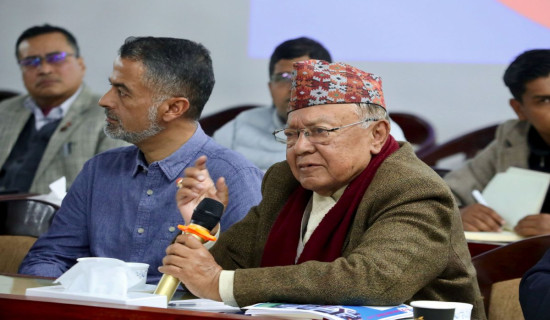- Tuesday, 23 December 2025
Disaster Management
Adorned with majestic mountains, picturesque villages perched on verdant hills, and plain lands brimming with paddy fields and parks and conservation areas, Nepal is truly a blessed country. These landscapes of unparalleled scenic beauty draw tourists from far and wide, contributing significantly to tourism recipients. But these geographical strengths are also its potential vulnerabilities. Earthquake occurrences are frequent. Climate change-induced extreme weather events have grown in frequency and intensity. Nepal is ranked among the most climate-vulnerable countries.
The biggest headache, however, is the annual monsoon disasters. Since its onset, the incessant rainfall has claimed 28 lives, one is missing and 25 others have been injured. Of them, 24 people have died from landslides and four from floods, In 93 incidents of lightning, 19 individuals have died and 35 were injured, with 46 houses being completely damaged and 36 houses partially damaged. Hundreds of cattle have also perished. Faced with imminent landslides or floods, thousands have been displaced. What's more, several of the highways and roads have been rendered unnavigable by landslides or due to big potholes formed with the washing away of asphalt.
In whatever form, disasters disrupt communities and can take a heavy toll on people, property, economies, and the environment. They often overwhelm community’s capacity to cope with. We can do little about the disasters, but we can surely minimise their impacts. The process to effectively do this is called disaster management. It entails adequately preparing for and responding to disasters before it is too late. Given the ferocity of monsoon, we have no time to waste to consolidate our disaster preparedness to mitigate the ravages.
We are in prime monsoon time and in this context, Prime Minister Pushpa Kamal Dahal Prachanda has said that the government must work with a high priority on disaster management despite turmoil in the political sphere. He called for the working of three security forces – the Nepal Police, Nepal Army, Armed Police Force – in tandem for systematic management of and preparedness for disasters. Pointing out the weakness due to procedural complexity that has prevented the mobilisation of disaster management funds, he called for its amendment so that the funds could be utilised in a hassle-free manner. With enough political will, we think, this obstacle will be removed.
At the same time, we mustn't hesitate to give credit where it's due. With commendable effort by the security agencies -- key responders in disasters on the ground -- many lives and properties have been saved. If we are to make their response more effective, there have been demands that there be clearer allocations of their assignments and duties depending on the nature and magnitude of disasters. The ambiguity in the mandates among agencies, or lack of coordination, is said to have posed challenges. This must be addressed.
Better disaster preparedness and management also includes building resilient infrastructure – like roads, bridges, electricity lines and stations and water supply systems – which are able to withstand disasters, early relocation of vulnerable settlements to safety, among others. Poorer communities have fewer resources to prepare themselves for a disaster or bounce back from its impact. The government needs to prioritise them. Haphazard construction of roads in villages with blatant disregard for proper geographical study and under the watch of qualified engineers by local levels has been a recipe for frequent disasters, especially landslides. This must also be stopped.

















